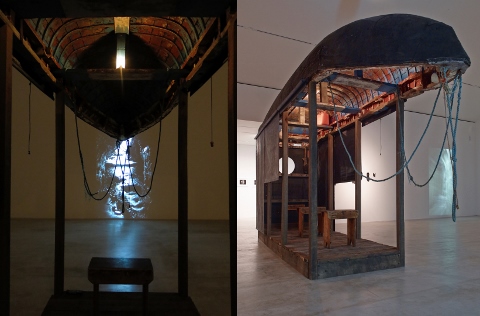Coast-Lines is a newly opened, year-long collection exhibition at the Irish Museum of Modern Art (IMMA). Showcasing the best of Ireland’s modern art reserve, it incorporates a multitude of mediums and charts various movements. The exhibition aims to challenge our perceptions of pattern, lines, surface, folds, enclosures, motion and place.
Art from the 1960s features prominently in the displays. One room houses a collection of books and newspaper clippings on optical, kinetic and conceptual art, which defined this era. Other interesting pieces in this section include geometric patterns played from video tapes on analogue televisions, as well as contemporary hologram-like prints by revered music producer Brian Eno, which reflect classic optical and kinetic art styles.
The Orthogonal Methods Group (OMG), a team of researchers based at Connect in Trinity, was invited to create a response piece to two experimental art initiatives, “Aspen 5+6” and “1967: Experiments in Art and Technology” as part of the exhibition. “Aspen 5+6” was groundbreaking for its time and was recognised as the first conceptual exhibition to discard gallery space. It takes the form of a magazine in a box, which contained 28 items and was originally delivered to subscribers. Consisting of sculptures, recordings, music scores and Twitter feeds, this project is complex and thought provoking enough to be its own stand-alone art show. It seems too intricate to fully fit in with the wider exhibition and feels slightly out of place.
One of the most striking displays is the “Tabernacle” by Dorothy Cross. The piece consists of a traditional Irish wooden canoe, known as a currach, overturned and propped up by wooden beams to form a shelter. This display was originally part of the set design for a production of JM Synge’s Riders to the Sea. Projected onto the wall facing the bow of the boat is a looped video of water lapping against rocks at the entrance of a cave. The room is completely dark and is effective overall in capturing a subterranean, shipwreck setting.
Following on from this blacked-out room is a contrasting clear, brightly lit space with white walls and floors. This distinct difference in lighting is visually stimulating for the viewer.
The room features a map of the Aran Islands imprinted on the ground – Tim Robinson’s “Map of Aran”. This unusual choice of placement works well in engaging the viewer. It feels interactive as one walks along it.
However, the overall thematic sense and layout of the exhibition both fall short. There are no numbers over the doors or on the walls of rooms, and the exhibition brochure does not include a floor plan. A visitor may have trouble navigating such an expansive exhibition, with very varied works and little clarity as to what is situated where.
On a whole, there seems to be a dissonance in the variety of works on display. Coast-Lines is a broad, loose title. The first rooms explore line and pattern, however, there seems to be a lack of cohesiveness and flow as one is led into more rooms, which feature tangible depictions of rocks and the sea. It jumps from abstract notions of coastlines to very literal examples, without a gradual transition. The viewer is left wondering how these works are interconnected or if they have perhaps strayed into another, different exhibition.







